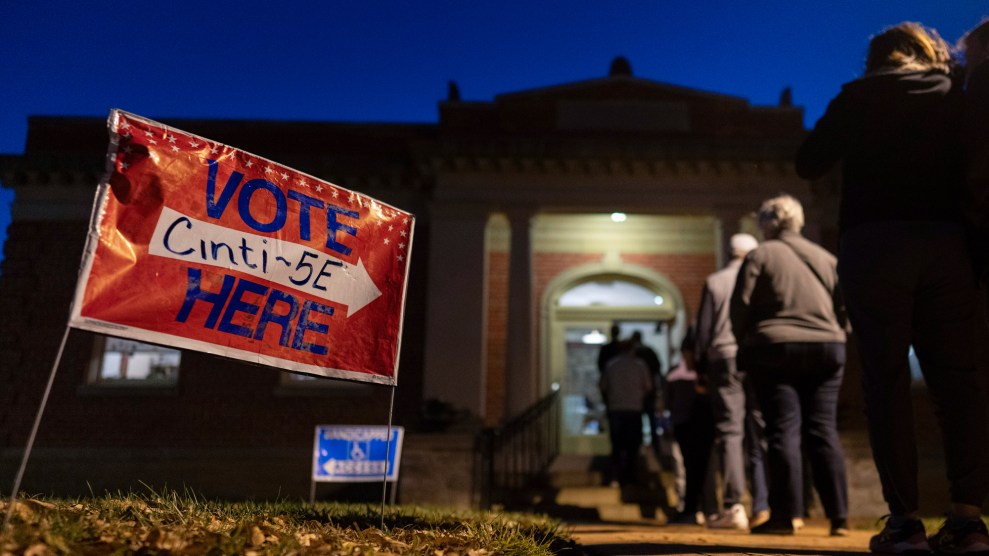
Voters line up to enter their polling place at the Cincinnati Observatory on Election Day.Carolyn Kaster/AP
Ohio voters defeated a major ballot initiative on Tuesday that would have ended partisan gerrymandering in the state and curbed the lopsided majorities Republicans hold in the state legislature and US House delegation. The measure, known as Issue 1, was voted down with 54 percent of the vote.
Republicans aggressively used their power to thwart a measure that seemingly had the support of a large majority of the state’s voters. Ohio voters passed two previous redistricting reform measures, in 2015 and 2018, with more than 70 percent of the vote each time.
But when it came time to put Issue 1 on the ballot, Ohio Republicans grossly misrepresented the intention of the measure, which would have created a citizens redistricting commission to draw new maps for the state legislature and US House after GOP legislative leaders gutted the previous redistricting initiatives. The summary of the ballot initiative adopted by the Ohio Ballot Board, which has a Republican majority, implied the measure would encourage partisan gerrymandering rather than curb it, claiming the initiative would “repeal constitutional protections against gerrymandering” and “manipulate the boundaries of state legislative and congressional districts to favor the two largest political parties in the state of Ohio.”
The board’s chair, GOP Secretary of State Frank LaRose, who lost the GOP primary for US Senate in 2024, is a member of the GOP-dominated redistricting commission that repeatedly voted for the state’s gerrymandered maps that gave Republicans supermajorities in both chambers—67 percent of seats in the state House and 69 percent in the state Senate, despite Trump only getting 53 percent of the vote in 2020. The Ohio Supreme Court struck down the gerrymandered state legislative and US House maps seven times, but Republicans like LaRose kept overriding the court’s opinions.
The group behind Issue 1, Citizens Not Politicians, which is led by former Ohio Supreme Court Chief Justice Maureen O’Connor, a Republican, immediately sued the ballot board, asking the Ohio Supreme Court to block the “biased, inaccurate, deceptive, and unconstitutional ballot language.”
But the Ohio Supreme Court, which gained a more conservative Republican majority after O’Connor’s retirement in 2022, largely approved the misleading language. That led to complaints from Ohio voters that they had been tricked into opposing a redistricting reform initiative that they actually supported.
As Bolts magazine reported:
When Songgu Kwon went to the polls earlier this month, he was eager to help Ohio adopt an independent redistricting commission. The comic book writer and illustrator, who lives near Athens, dislikes the process with which politicians have carved up Ohio into congressional and legislative districts that favor them, enabling Republicans to lock in large majorities. So he was pleased that voting rights groups had placed Issue 1, a proposal meant to create fairer maps, on the Ohio ballot this fall.
“I’m in support of any measures that make the process more fair to reflect the will of the people, instead of letting the politicians decide how to gerrymander,” says Kwon.
In the voting booth, he reviewed the text in front of him. His ballot read that voting ‘yes’ would set up a panel “required to gerrymander the boundaries of state legislative and congressional districts,” and that it would “repeal constitutional protections against gerrymandering.”
So Kwon voted ‘no’ on the measure—given what he’d just read, he thought, that had to be the way to signal support for independent redistricting. He’d gone in planning to vote ‘yes,’ but he was thrown off by this language he saw; he guessed that he must have been wrong or missed some recent development. “The language seemed really specific that if you vote ‘yes’, you’re for gerrymandering,” he now recalls in frustration.
But when he left the polling station and compared notes with his wife, he quickly figured out that he’d made a mistake: He had just voted to preserve the status quo. To bring about the new independent process and remove redistricting from elected officials, as was his intention, he would have had to vote ‘yes.’
Those reports of confused voters were widespread. Eight in 10 Ohioans told pollsters they believed that it was important that “a candidate of one political party isn’t always guaranteed to win” when it comes to drawing legislative districts. But when the misleading GOP-crated ballot summary was read to voters, support dropped precipitously.
The result is a major defeat for democracy reform efforts nationwide. And it was also a sign of how Republicans were using their entrenched power to thwart direct democracy.
That happened in other states as well. In Florida, 57 percent of voters supported a measure to enshrine protections for reproductive rights in the state. But it became the first to fail to pass an abortion rights measure since the Supreme Court overturned Roe v. Wade because Florida requires a 60 percent supermajority to pass a ballot initiative and the state’s Republican Gov. Ron DeSantis campaigned heavily against it, even going so far to send his election fraud police to the homes of voters who signed a petition supporting abortion rights. That was a brazen abuse of power, but it was par for the course in the GOP’s bid to preserve minority rule.
















